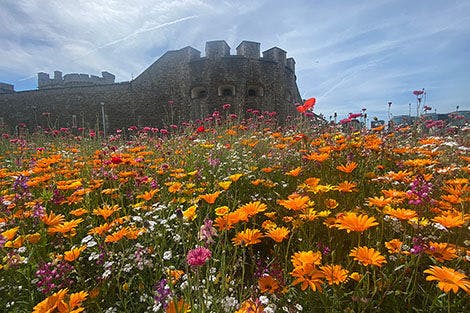
Sustainability strategy
Being a charity for everyone means acting not just for those who currently experience our sites but also for those in future generations. This means responding to our impact on both climate change and nature loss and ensuring our buildings, collections and staff are resilient to the changes already upon us.
Historic Royal Palaces will achieve nature positive, carbon net zero by 2050 and our 2024-2027 Action Plan sets out the foundations to achieve this, including:
- reducing our energy consumption and removing fossil fuels from our sites.
- understanding the health and biodiversity on our sites and acting to protect and enhance it.
- reducing our water consumption and finding new ways to harvest and store rainwater.
- reducing our waste and exploring viable options within a circular economy.
- improving our data collection so we can measure our progress more accurately.
- working in partnership with other organisations to drive change more broadly.
Download
Sustainability performance
We are committed to being open about our sustainability performance and will publish our progress within our Annual accounts.
Read our financial statement to find detailed information on our sustainability performance in 2022/2023.
2022/23 Financial statementBiodiversity at our palaces
Tap on the bottom of the image to scroll through the story.

Tower of London moat - the legacy of Superbloom
2024 will see the final year of the hugely successful Moat in Bloom project project which transformed the moat from a lawn into a thriving annual flowering meadow for the late Queen’s Platinum Jubilee. Over the last three years we’ve welcomed thousands of visitors to this tranquil oasis in the middle of the city and partnered with over 1,500 schools to design and create gardens in the spirit of the Tower of London's Moat in Bloom.
Over the course of 2025, the Tower Moat will evolve into its permanent landscape, creating even more sustainable habitats that will continue to provide space for pollinators and other species but also allow us to manage water more sustainably both for irrigation and to shore up theTower’s flood defences.

How compost can help your garden flourish
Gardens manager Claire Woods explores how compost is used in the gardens at Hillsborough Castle and shares some expert advice for your own garden at home.

Rare and Historic Northern Irish Plant Varieties at Hillsborough Castle and Gardens
Northern Ireland is home to a rich variety of rare and historic plants, many of which can be found at Hillsborough Castle and Gardens.
Gardens Manager Claire Woods explores the history behind growing these plants and the importance of conserving them for future generations.
